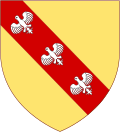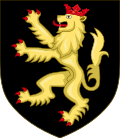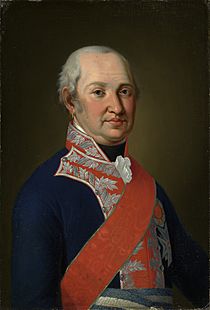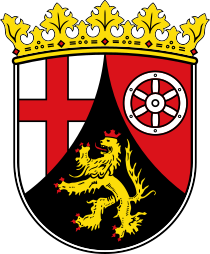Electoral Palatinate facts for kids
Quick facts for kids
Electorate of the Palatinate
|
|||||||||||||||||||||
|---|---|---|---|---|---|---|---|---|---|---|---|---|---|---|---|---|---|---|---|---|---|
| 1085–1803 | |||||||||||||||||||||
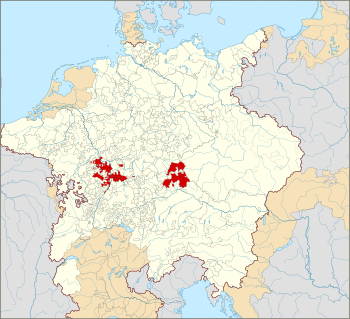
Territory of the Electoral Palatinate in 1618, prior to the Thirty Years' War
|
|||||||||||||||||||||
| Status | State of the Holy Roman Empire | ||||||||||||||||||||
| Capital |
49°30′N 8°01′E / 49.5°N 8.02°E |
||||||||||||||||||||
| Common languages | German Palatine German |
||||||||||||||||||||
| Religion | Population: Roman Catholic (to 1556), Lutheran (1556–1563) and Calvinist (from 1563). Elector: Catholic (to 1530s, from 1685), Lutheran (1530s–1559, 1575–1583), Calvinist (1559–1575, 1583–1685). |
||||||||||||||||||||
| Government | Hereditary monarchy | ||||||||||||||||||||
| Elector | |||||||||||||||||||||
|
• 1085–1095
|
Henry of Laach (first) | ||||||||||||||||||||
|
• 1799–1803
|
Maximilian Joseph (last) | ||||||||||||||||||||
| Historical era | Middle Ages/ Renaissance |
||||||||||||||||||||
|
• Demotion of the Count Palatine of Lotharingia
|
1085 | ||||||||||||||||||||
| 10 January 1356 | |||||||||||||||||||||
| 15 May – 24 October 1648 | |||||||||||||||||||||
|
• Subsumed by Bavaria
|
30 December 1777 | ||||||||||||||||||||
| 9 February 1801 | |||||||||||||||||||||
|
• Annexed by Baden
|
27 April 1803 | ||||||||||||||||||||
|
|||||||||||||||||||||
| Today part of |
|
||||||||||||||||||||
The Electoral Palatinate (called Kurpfalz in German) was an important state within the Holy Roman Empire. It existed for a very long time, from around 1085 until 1803. Its rulers were known as prince-electors, or Kurfürsten, who had the special job of helping to choose the Holy Roman Emperor.
The Palatinate's land was mostly along the Rhine River in what is now Germany. It included parts of today's Rhineland-Palatinate, Hesse, and Baden-Württemberg. Its main cities were Heidelberg and later Mannheim. The Palatinate was a powerful state, but it also faced many wars and changes over the centuries.
Contents
History of the Palatinate
Early Beginnings
Long ago, around the year 535, there was a special job called "Count Palatine." These counts were like the king's main helpers in certain areas. They were different from dukes, who had more independent power. Over time, this job became something that was passed down in families.
The most important Count Palatine was in a region called Lotharingia. By the year 985, a family called the Ezzonids held this title. Their lands were spread out, but they focused their power near the Rhine River.
Around 1085, the Count Palatine's military power in Lotharingia ended. The new Count Palatine, Henry of Laach, became a ruler over his own lands along the Upper Rhine. This area then became known as the County Palatine of the Rhine.
Becoming an Electorate
In 1156, Conrad, who was the half-brother of Emperor Frederick Barbarossa, became the first Count Palatine of the Rhine whose title was passed down through his family. He moved his main home to Heidelberg around 1182.
Later, in 1214, the Wittelsbach family from Bavaria took over the Palatinate. This family would rule the Palatinate until 1918. In 1294, the Wittelsbach lands were split. One part was the Rhenish Palatinate along the Rhine, and the other was a region called the Upper Palatinate (Oberpfalz) further east.
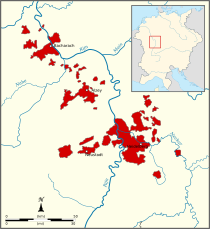
A very important event happened in 1356. The Palatinate was officially recognized as one of the seven prince-electors of the Holy Roman Empire. This meant the Count Palatine of the Rhine had a special vote in choosing the Emperor. From then on, the ruler was usually called the Elector Palatine.
Over time, the Wittelsbach family divided their lands even more among different family branches. This led to several smaller Palatinate states. In the 1530s, the Elector Palatine became a Lutheran. Then, in 1559, the main family line died out. The Electorate went to Frederick III, who was a strong Calvinist. This made the Palatinate a major center for Calvinism in Europe.
The Thirty Years' War
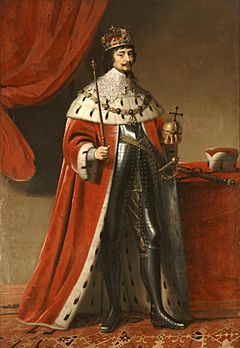
In 1619, Frederick V, who was a Protestant, accepted the throne of Bohemia. This decision started the Thirty Years' War (1618–1648). This war was one of the most destructive conflicts in history, causing huge losses of life and destruction across Germany.
Frederick V was defeated in 1620 and had to leave Bohemia. His lands in the Palatinate were taken over by Spanish and Bavarian armies. Frederick was forced to live in exile. His title and electoral rights were given to Maximilian I of Bavaria, who was Catholic.
After the war ended in 1648 with the Peace of Westphalia, Frederick's son, Charles Louis, got back the Lower Palatinate and the title of 'Elector Palatine'. However, the Palatinate was badly damaged by the war.
The Nine Years' War
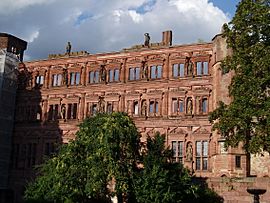
In 1685, the direct family line of the Electors Palatine ended. This led to a dispute over who should rule next. King Louis XIV of France claimed the Palatinate for France because his brother had married an Elector Palatine's sister.
In 1688, France invaded the Palatinate to push its claim. This led to the Nine Years' War. The French army was forced to leave in 1689. But before they left, they destroyed much of Heidelberg, including its famous castle, and many other towns and villages. This destruction shocked people across Europe. France later gave up its claim to the region in 1697.
Later, in 1777, the Elector Palatine, Charles Theodore, also inherited the Electorate of Bavaria. This meant the two states were now ruled by the same person. The Palatinate's separate power began to fade.
The End of the Palatinate
The Palatinate's story as an independent state ended during the Napoleonic Wars. In 1795, the French army took over the Palatinate lands on the left bank of the Rhine River. The last Elector, Maximilian Joseph, accepted this loss in 1802.
In 1803, the remaining parts of the Palatinate were divided among other states, mainly Baden and Bavaria. This event, called the German mediatisation, officially ended the Electoral Palatinate.
Coat of arms and flag
| Coat of arms of the Electoral Palatinate |
|
|---|---|
 |
|
| Armiger | Elector of the Palatinate |
The Palatinate's coat of arms has a long history. In 1156, when Conrad of Hohenstaufen became Count Palatine, the old symbol of his family, a single lion, became the symbol for the Palatinate.
Over time, the Palatinate's coat of arms was combined with symbols from other families, like the Wittelsbachs. The Wittelsbach family also used the Bavarian arms. From 1356, a golden orb (a ball with a cross on top) was added. This orb showed their important role as the Arch-Steward of the Holy Roman Empire.
- Coats of arms:
-
House of Hohenstaufen (before confirmation as Electorate)
-
House of Wittelsbach (Electoral Palatinate)
-
Greater Coat of arms from 1703
- Flags:
-
The variant used by Wittelsbachs who inherited the Palatinate in the mid-14th century
-
1604 design
What Happened Next
After 1803, the lands of the former Palatinate became parts of different German states. At the Congress of Vienna in 1814 and 1815, some southern parts were given to the Austrian Empire.
In 1816, a large part of the Palatinate became a formal part of the Kingdom of Bavaria. This area was known as the Rheinkreis (Circle of the Rhine). It remained part of Bavaria until after World War II.
In September 1946, the territory became part of the new German state of Rhineland-Palatinate. Today, the Palatinate region is a part of this federal state in Germany.
See also
 In Spanish: Electorado del Palatinado para niños
In Spanish: Electorado del Palatinado para niños
- Count palatine
- German Palatines





